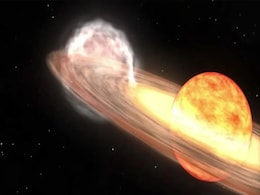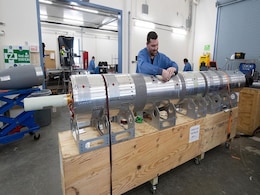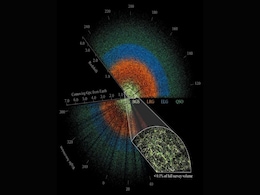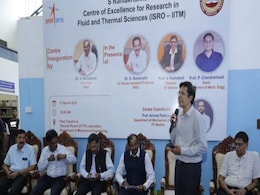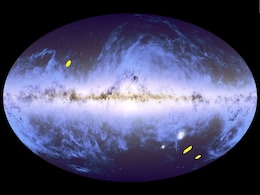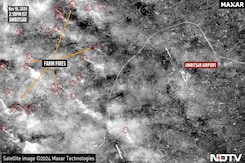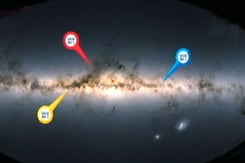Space Scientist
- All
- News
- Videos
- Web Stories
-

NASA’s SPHEREx Mission Sends First Space Images Before Full Sky Survey
- Thursday April 3, 2025
- Written by Gadgets 360 Staff
NASA’s SPHEREx telescope has captured its first images from space, marking a critical milestone before its full-sky infrared survey begins. The observatory, launched on March 11, recorded thousands of light sources, including distant galaxies and stars. Unlike other space telescopes, SPHEREx is designed for large-scale cosmic mapping, scanning th...
-
 www.gadgets360.com
www.gadgets360.com
-

Laboratory Test Shows Ion-Molecule Collision Theory Fails to Produce Benzene in Space Conditions
- Thursday April 3, 2025
- Written by Gadgets 360 Staff
A recent laboratory experiment conducted by researchers at JILA and NIST has disproved a long-held theory about how benzene forms in interstellar space. The study tested ion-molecule collisions at near-zero temperatures and extremely low pressure but failed to produce benzene. This challenges earlier theories linking benzene to the formation of car...
-
 www.gadgets360.com
www.gadgets360.com
-

T Corona Borealis May Erupt Soon: Rare Nova Could Be Visible to Naked Eye
- Tuesday April 1, 2025
- Written by Gadgets 360 Staff
T Corona Borealis, a binary star system in the Northern Crown constellation, is showing signs of an imminent nova eruption. The white dwarf star, which pulls material from its red giant companion, last erupted in 1946. Astronomers have detected patterns similar to previous eruptions, leading to predictions of a possible outburst within the next two...
-
 www.gadgets360.com
www.gadgets360.com
-

James Webb Telescope Captures Neptune’s Auroras in Stunning Detail
- Monday March 31, 2025
- Written by Gadgets 360 Staff
The James Webb Space Telescope has provided the first-ever direct images of Neptune’s auroras, revealing surprising details about the ice giant’s atmosphere. Unlike auroras on Earth, Jupiter, or Saturn, Neptune’s auroras appear across unexpected locations due to its tilted and offset magnetic field. Scientists also detected the presence of H...
-
 www.gadgets360.com
www.gadgets360.com
-

Did Black Hole Radiation Shape the Universe?
- Saturday March 29, 2025
- Written by Gadgets 360 Staff
A study suggests that Hawking radiation, first proposed by Stephen Hawking, may have influenced the universe’s structure. According to reports, primordial black holes that existed in the early universe could have evaporated through Hawking radiation, impacting matter distribution. The research explores how these black holes might have shaped gala...
-
 www.gadgets360.com
www.gadgets360.com
-

NASA to Launch Three Rockets in Alaska to Study Auroral Substorms’ Impact
- Saturday March 29, 2025
- Written by Gadgets 360 Staff
NASA is conducting a rocket experiment from Poker Flat Research Range in Alaska. Three rockets will launch within a three-hour window to study how auroral substorms influence the Earth's upper atmosphere. Scientists will observe whether auroras drive vertical convection or if acoustic-buoyancy waves spread their energy over a wider region. Vapour t...
-
 www.gadgets360.com
www.gadgets360.com
-

New Study Challenges Claims of Vast Underground Water on Mars
- Thursday March 27, 2025
- Written by Gadgets 360 Staff
Mars’ water history remains a mystery as new research questions the claim that vast amounts of water are stored beneath its surface. A study led by Bruce Jakosky argues that previous estimates of Mars’ mid-crust being saturated with liquid water may be inaccurate. The findings challenge earlier interpretations of seismic data from NASA’s InSi...
-
 www.gadgets360.com
www.gadgets360.com
-

New Research Suggests Dark Energy Is Evolving, Challenging Cosmology Models
- Wednesday March 26, 2025
- Written by Gadgets 360 Staff
New research from the DESI project suggests that dark energy, once thought to be a constant force, may actually be changing over time. This challenges long-held cosmological models that assume a stable influence of dark energy on the universe’s expansion. By mapping 15 million galaxies, DESI’s data raises new questions about cosmic evolution. S...
-
 www.gadgets360.com
www.gadgets360.com
-

ISRO and IIT Madras Unveil Research Centre for Space Thermal Sciences
- Wednesday March 26, 2025
- Written by Gadgets 360 Staff
ISRO and IIT Madras have launched the S Ramakrishnan Centre of Excellence for Research in Fluid and Thermal Sciences. The facility, inaugurated on 17 March 2025, will focus on spacecraft cooling, fluid dynamics, and cryogenic engine advancements. Housed in IIT Madras’ Department of Mechanical Engineering, it will facilitate collaboration between ...
-
 www.gadgets360.com
www.gadgets360.com
-

French Scientist Denied Entry To US After Officials Find Texts Critical Of Trump On His Phone
- Thursday March 20, 2025
- World News | Edited by Ritu Singh
The incident unfolded on March 9, when the French space researcher was barred from entering the United States upon arrival in Texas/
-
 www.ndtv.com
www.ndtv.com
-

Supernova Remnants Found in Oceanic Samples, Scientists Look to Moon
- Wednesday March 26, 2025
- Written by Gadgets 360 Staff
Scientists have identified supernova debris in deep-sea sediments, including a rare plutonium isotope linked to a kilonova. Researchers believe a neutron star collision occurred nearly 10 million years ago, scattering radioactive material across space. To validate this theory, they plan to analyze lunar soil, which remains undisturbed by Earth's ge...
-
 www.gadgets360.com
www.gadgets360.com
-

ESA’s Euclid Telescope Releases First Data, Mapping 26 Million Galaxies
- Wednesday March 26, 2025
- Written by Gadgets 360 Staff
ESA’s Euclid telescope has released its first dataset, mapping 26 million galaxies within a week. The observations include deep-field images, a survey of 380,000 galaxies, and 500 new gravitational lens candidates. Scientists will continue tracking cosmic evolution over six years. The dataset, currently 35 terabytes, is expected to grow to 2 peta...
-
 www.gadgets360.com
www.gadgets360.com
-

Neil deGrasse Tyson's "Send Elon Musk's Mom" Test For Going To Space
- Thursday March 20, 2025
- World News | Edited by Chandrajit Mitra
For Neil deGrasse Tyson, an acclaimed astrophysicist, travel to Mars will be deemed safe only after tech billionaire Elon Musk's mother visits the red planet that has been space scientists' obsession for decades.
-
 www.ndtv.com
www.ndtv.com
-

Wolf-Rayet 104's Orbit Tilt Reduces Gamma-Ray Burst Threat, Study Finds
- Thursday March 20, 2025
- Written by Gadgets 360 Staff
New research using Keck Observatory’s instruments confirms that the orbit of Wolf-Rayet 104 is tilted 30-40 degrees away from Earth, lowering concerns about a possible gamma-ray burst. Previously, it was believed that the system’s alignment could pose a risk. However, spectroscopy data now challenges these assumptions, raising new questions abo...
-
 www.gadgets360.com
www.gadgets360.com
-

European Space Agency Pays Volunteers Rs 4.7 Lakh For 10 Days Of Bed Rest. Here's Why
- Saturday March 15, 2025
- Science | Edited by Abhinav Singh
Volunteers have been asked to lie down on a waterbed for 10 days as part of a dry immersion study to recreate the effects of spaceflight on human body.
-
 www.ndtv.com
www.ndtv.com
-

NASA’s SPHEREx Mission Sends First Space Images Before Full Sky Survey
- Thursday April 3, 2025
- Written by Gadgets 360 Staff
NASA’s SPHEREx telescope has captured its first images from space, marking a critical milestone before its full-sky infrared survey begins. The observatory, launched on March 11, recorded thousands of light sources, including distant galaxies and stars. Unlike other space telescopes, SPHEREx is designed for large-scale cosmic mapping, scanning th...
-
 www.gadgets360.com
www.gadgets360.com
-

Laboratory Test Shows Ion-Molecule Collision Theory Fails to Produce Benzene in Space Conditions
- Thursday April 3, 2025
- Written by Gadgets 360 Staff
A recent laboratory experiment conducted by researchers at JILA and NIST has disproved a long-held theory about how benzene forms in interstellar space. The study tested ion-molecule collisions at near-zero temperatures and extremely low pressure but failed to produce benzene. This challenges earlier theories linking benzene to the formation of car...
-
 www.gadgets360.com
www.gadgets360.com
-

T Corona Borealis May Erupt Soon: Rare Nova Could Be Visible to Naked Eye
- Tuesday April 1, 2025
- Written by Gadgets 360 Staff
T Corona Borealis, a binary star system in the Northern Crown constellation, is showing signs of an imminent nova eruption. The white dwarf star, which pulls material from its red giant companion, last erupted in 1946. Astronomers have detected patterns similar to previous eruptions, leading to predictions of a possible outburst within the next two...
-
 www.gadgets360.com
www.gadgets360.com
-

James Webb Telescope Captures Neptune’s Auroras in Stunning Detail
- Monday March 31, 2025
- Written by Gadgets 360 Staff
The James Webb Space Telescope has provided the first-ever direct images of Neptune’s auroras, revealing surprising details about the ice giant’s atmosphere. Unlike auroras on Earth, Jupiter, or Saturn, Neptune’s auroras appear across unexpected locations due to its tilted and offset magnetic field. Scientists also detected the presence of H...
-
 www.gadgets360.com
www.gadgets360.com
-

Did Black Hole Radiation Shape the Universe?
- Saturday March 29, 2025
- Written by Gadgets 360 Staff
A study suggests that Hawking radiation, first proposed by Stephen Hawking, may have influenced the universe’s structure. According to reports, primordial black holes that existed in the early universe could have evaporated through Hawking radiation, impacting matter distribution. The research explores how these black holes might have shaped gala...
-
 www.gadgets360.com
www.gadgets360.com
-

NASA to Launch Three Rockets in Alaska to Study Auroral Substorms’ Impact
- Saturday March 29, 2025
- Written by Gadgets 360 Staff
NASA is conducting a rocket experiment from Poker Flat Research Range in Alaska. Three rockets will launch within a three-hour window to study how auroral substorms influence the Earth's upper atmosphere. Scientists will observe whether auroras drive vertical convection or if acoustic-buoyancy waves spread their energy over a wider region. Vapour t...
-
 www.gadgets360.com
www.gadgets360.com
-

New Study Challenges Claims of Vast Underground Water on Mars
- Thursday March 27, 2025
- Written by Gadgets 360 Staff
Mars’ water history remains a mystery as new research questions the claim that vast amounts of water are stored beneath its surface. A study led by Bruce Jakosky argues that previous estimates of Mars’ mid-crust being saturated with liquid water may be inaccurate. The findings challenge earlier interpretations of seismic data from NASA’s InSi...
-
 www.gadgets360.com
www.gadgets360.com
-

New Research Suggests Dark Energy Is Evolving, Challenging Cosmology Models
- Wednesday March 26, 2025
- Written by Gadgets 360 Staff
New research from the DESI project suggests that dark energy, once thought to be a constant force, may actually be changing over time. This challenges long-held cosmological models that assume a stable influence of dark energy on the universe’s expansion. By mapping 15 million galaxies, DESI’s data raises new questions about cosmic evolution. S...
-
 www.gadgets360.com
www.gadgets360.com
-

ISRO and IIT Madras Unveil Research Centre for Space Thermal Sciences
- Wednesday March 26, 2025
- Written by Gadgets 360 Staff
ISRO and IIT Madras have launched the S Ramakrishnan Centre of Excellence for Research in Fluid and Thermal Sciences. The facility, inaugurated on 17 March 2025, will focus on spacecraft cooling, fluid dynamics, and cryogenic engine advancements. Housed in IIT Madras’ Department of Mechanical Engineering, it will facilitate collaboration between ...
-
 www.gadgets360.com
www.gadgets360.com
-

French Scientist Denied Entry To US After Officials Find Texts Critical Of Trump On His Phone
- Thursday March 20, 2025
- World News | Edited by Ritu Singh
The incident unfolded on March 9, when the French space researcher was barred from entering the United States upon arrival in Texas/
-
 www.ndtv.com
www.ndtv.com
-

Supernova Remnants Found in Oceanic Samples, Scientists Look to Moon
- Wednesday March 26, 2025
- Written by Gadgets 360 Staff
Scientists have identified supernova debris in deep-sea sediments, including a rare plutonium isotope linked to a kilonova. Researchers believe a neutron star collision occurred nearly 10 million years ago, scattering radioactive material across space. To validate this theory, they plan to analyze lunar soil, which remains undisturbed by Earth's ge...
-
 www.gadgets360.com
www.gadgets360.com
-

ESA’s Euclid Telescope Releases First Data, Mapping 26 Million Galaxies
- Wednesday March 26, 2025
- Written by Gadgets 360 Staff
ESA’s Euclid telescope has released its first dataset, mapping 26 million galaxies within a week. The observations include deep-field images, a survey of 380,000 galaxies, and 500 new gravitational lens candidates. Scientists will continue tracking cosmic evolution over six years. The dataset, currently 35 terabytes, is expected to grow to 2 peta...
-
 www.gadgets360.com
www.gadgets360.com
-

Neil deGrasse Tyson's "Send Elon Musk's Mom" Test For Going To Space
- Thursday March 20, 2025
- World News | Edited by Chandrajit Mitra
For Neil deGrasse Tyson, an acclaimed astrophysicist, travel to Mars will be deemed safe only after tech billionaire Elon Musk's mother visits the red planet that has been space scientists' obsession for decades.
-
 www.ndtv.com
www.ndtv.com
-

Wolf-Rayet 104's Orbit Tilt Reduces Gamma-Ray Burst Threat, Study Finds
- Thursday March 20, 2025
- Written by Gadgets 360 Staff
New research using Keck Observatory’s instruments confirms that the orbit of Wolf-Rayet 104 is tilted 30-40 degrees away from Earth, lowering concerns about a possible gamma-ray burst. Previously, it was believed that the system’s alignment could pose a risk. However, spectroscopy data now challenges these assumptions, raising new questions abo...
-
 www.gadgets360.com
www.gadgets360.com
-

European Space Agency Pays Volunteers Rs 4.7 Lakh For 10 Days Of Bed Rest. Here's Why
- Saturday March 15, 2025
- Science | Edited by Abhinav Singh
Volunteers have been asked to lie down on a waterbed for 10 days as part of a dry immersion study to recreate the effects of spaceflight on human body.
-
 www.ndtv.com
www.ndtv.com



